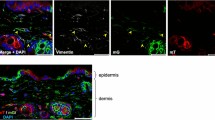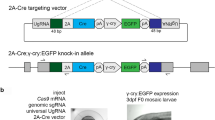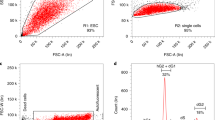Abstract
The biomedical application of human embryonic stem (hES) cells will increasingly depend on the availability of technologies for highly controlled genetic modification. In mouse genetics, conditional mutagenesis using site-specific recombinases has become an invaluable tool for gain- and loss-of-function studies. Here we report highly efficient Cre-mediated recombination of a chromosomally integrated loxP-modified allele in hES cells and hES cell–derived neural precursors by protein transduction. Recombinant modified Cre recombinase protein translocates into the cytoplasm and nucleus of hES cells and subsequently induces recombination in virtually 100% of the cells. Cre-transduced hES cells maintain the expression of pluripotency markers as well as the capability of differentiating into derivatives of all three germ layers in vitro and in vivo. We expect this technology to provide an important technical basis for analyzing complex genetic networks underlying human development as well as generating highly purified, transplantable hES cell–derived cells for regenerative medicine.
This is a preview of subscription content, access via your institution
Access options
Subscribe to this journal
Receive 12 print issues and online access
$259.00 per year
only $21.58 per issue
Buy this article
- Purchase on Springer Link
- Instant access to full article PDF
Prices may be subject to local taxes which are calculated during checkout





Similar content being viewed by others
References
Smith, A.G. Embryo-derived stem cells: of mice and men. Annu. Rev. Cell Dev. Biol. 17, 435–462 (2001).
Thomson, J.A. et al. Embryonic stem cell lines derived from human blastocysts. Science 282, 1145–1147 (1998).
Amit, M. et al. Clonally derived human embryonic stem cell lines maintain pluripotency and proliferative potential for prolonged periods of culture. Dev. Biol. 227, 271–278 (2000).
Daley, G.Q., Goodell, M.A. & Snyder, E.Y. Realistic prospects for stem cell therapeutics. Hematology (Am. Soc. Hematol. Educ. Program) 398–418 (2003).
Brüstle, O. et al. Embryonic stem cell-derived glial precursors: a source of myelinating transplants. Science 285, 754–756 (1999).
Blyszczuk, P. et al. Expression of Pax4 in embryonic stem cells promotes differentiation of nestin-positive progenitor and insulin-producing cells. Proc. Natl. Acad. Sci. USA 100, 998–1003 (2003).
Andersson, E. et al. Identification of intrinsic determinants of midbrain dopamine neurons. Cell 124, 393–405 (2006).
Klug, M.G., Soonpaa, M.H., Koh, G.Y. & Field, L.J. Genetically selected cardiomyocytes from differentiating embronic stem cells form stable intracardiac grafts. J. Clin. Invest. 98, 216–224 (1996).
Li, M., Pevny, L., Lovell-Badge, R. & Smith, A. Generation of purified neural precursors from embryonic stem cells by lineage selection. Curr. Biol. 8, 971–974 (1998).
Branda, C.S. & Dymecki, S.M. Talking about a revolution: the impact of site-specific recombinases on genetic analyses in mice. Dev. Cell 6, 7–28 (2004).
Lewandoski, M. Conditional control of gene expression in the mouse. Nat. Rev. Genet. 2, 743–755 (2001).
Buch, T. et al. A Cre-inducible diphtheria toxin receptor mediates cell lineage ablation after toxin administration. Nat. Methods 2, 419–426 (2005).
Tan, S.M. & Droge, P. Comparative analysis of sequence-specific DNA recombination systems in human embryonic stem cells. Stem Cells 23, 868–873 (2005).
Nagahara, H. et al. Transduction of full-length TAT fusion proteins into mammalian cells: TAT-p27Kip1 induces cell migration. Nat. Med. 4, 1449–1452 (1998).
Jo, D. et al. Epigenetic regulation of gene structure and function with a cell-permeable Cre recombinase. Nat. Biotechnol. 19, 929–933 (2001).
Peitz, M., Pfannkuche, K., Rajewsky, K. & Edenhofer, F. Ability of the hydrophobic FGF and basic TAT peptides to promote cellular uptake of recombinant Cre recombinase: a tool for efficient genetic engineering of mammalian genomes. Proc. Natl. Acad. Sci. USA 99, 4489–4494 (2002).
Will, E. et al. Unmodified Cre recombinase crosses the membrane. Nucleic Acids Res. 30, e59 (2002).
Joshi, S.K., Hashimoto, K. & Koni, P.A. Induced DNA recombination by Cre recombinase protein transduction. Genesis 33, 48–54 (2002).
Zhang, S.C., Wernig, M., Duncan, I.D., Brüstle, O. & Thomson, J.A. In vitro differentiation of transplantable neural precursors from human embryonic stem cells. Nat. Biotechnol. 19, 1129–1133 (2001).
Eiges, R. et al. Establishment of human embryonic stem cell-transfected clones carrying a marker for undifferentiated cells. Curr. Biol. 11, 514–518 (2001).
Lakshmipathy, U. et al. Efficient transfection of embryonic and adult stem cells. Stem Cells 22, 531–543 (2004).
Glover, D.J., Lipps, H.J. & Jans, D.A. Towards safe, non-viral therapeutic gene expression in humans. Nat. Rev. Genet. 6, 299–310 (2005).
Hacein-Bey-Abina, S. et al. A serious adverse event after successful gene therapy for X-linked severe combined immunodeficiency. N. Engl. J. Med. 348, 255–256 (2003).
Silver, D.P. & Livingston, D.M. Self-excising retroviral vectors encoding the Cre recombinase overcome Cre-mediated cellular toxicity. Mol. Cell 8, 233–243 (2001).
Schmidt, E.E., Taylor, D.S., Prigge, J.R., Barnett, S. & Capecchi, M.R. Illegitimate Cre-dependent chromosome rearrangements in transgenic mouse spermatids. Proc. Natl. Acad. Sci. USA 97, 13702–13707 (2000).
Loonstra, A. et al. Growth inhibition and DNA damage induced by Cre recombinase in mammalian cells. Proc. Natl. Acad. Sci. USA 98, 9209–9214 (2001).
Pfeifer, A., Brandon, E.P., Kootstra, N., Gage, F.H. & Verma, I.M. Delivery of the Cre recombinase by a self-deleting lentiviral vector: efficient gene targeting in vivo. Proc. Natl. Acad. Sci. USA 98, 11450–11455 (2001).
Zwaka, T.P. Homologous recombination in human embryonic stem cells. Nat. Biotechnol. 21, 319–321 (2003).
Wunderlich, F.T., Wildner, H., Rajewsky, K. & Edenhofer, F. New variants of inducible Cre recombinase: a novel mutant of Cre-PR fusion protein exhibits enhanced sensitivity and an expanded range of inducibility. Nucleic Acids Res. 29, e47 (2001).
Stojkovic, P. et al. An autogeneic feeder cell system that efficiently supports growth of undifferentiated human embryonic stem cells. Stem Cells 23, 306–314 (2005).
Acknowledgements
We thank J. Itskovitz-Eldor for providing the H9.2 cell line and E. Kolossov for providing materials. Also, we thank S. Terstegge and C. Benzing for the initial set up of the hES culture and M. Peitz, E. Endl, L. Heukamp as well as members of the Stem Cell Engineering Group for support and valuable discussions. We thank M. Segschneider, A. Leinhaas and members of the histology laboratory of the Institute of Neuropathology, University of Bonn, for technical assistance with embryoid body staining and teratoma analysis. This work was supported by grants from the Stem Cell Network North Rhine Westphalia (400 004 03), the European Union (LSHB-CT-20003-503005; EUROSTEMCELL), the Volkswagen Foundation (Az I/77864), and grants from the Deutsche Forschungsgemeinschaft (BR 1337/3-2) and the Hertie Foundation.
Author information
Authors and Affiliations
Corresponding author
Ethics declarations
Competing interests
The authors declare no competing financial interests.
Supplementary information
Supplementary Fig. 1
Validation of the FDR construct. (PDF 351 kb)
Supplementary Fig. 2
Native eGFP fluorescence of Cre-transduced hES-FDR1 cells. (PDF 344 kb)
Supplementary Fig. 3
Maintenance of pluripotency of Cre-transduced hES-FDR1 cells. (PDF 1192 kb)
Supplementary Table 1
Construction of pFDR Cre reporter plasmid. (PDF 140 kb)
Rights and permissions
About this article
Cite this article
Nolden, L., Edenhofer, F., Haupt, S. et al. Site-specific recombination in human embryonic stem cells induced by cell-permeant Cre recombinase. Nat Methods 3, 461–467 (2006). https://doi.org/10.1038/nmeth884
Received:
Accepted:
Published:
Issue Date:
DOI: https://doi.org/10.1038/nmeth884
This article is cited by
-
Antibody-based protection against respiratory syncytial virus in mice and their offspring through vectored immunoprophylaxis
Gene Therapy (2023)
-
A ligand-based system for receptor-specific delivery of proteins
Scientific Reports (2019)
-
A method using electroporation for the protein delivery of Cre recombinase into cultured Arabidopsis cells with an intact cell wall
Scientific Reports (2019)
-
Matrix metalloproteinase-9 (MMP9) is involved in the TNF-α-induced fusion of human M13SV1-Cre breast epithelial cells and human MDA-MB-435-pFDR1 cancer cells
Cell Communication and Signaling (2018)
-
PD-1 is a haploinsufficient suppressor of T cell lymphomagenesis
Nature (2017)



